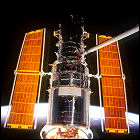 Congress approves the largest NASA budget in ten years, including authorization and funding for two major unmanned spacecraft: a Space Telescope to be deployed into Earth orbit via Space Shuttle, and a yet-to-be-named Jupiter orbiter and atmospheric probe, originally proposed in the late 1960s as part of the outer planets Grand Tour mission plan. The Jupiter probe, which must be ready to launch in 1982 to take advantage of a planetary configuration providing the shortest distance between Earth and Jupiter, is the subject of a fierce budget fight in Congress. (This spacecraft will go on to be named Galileo.)
Congress approves the largest NASA budget in ten years, including authorization and funding for two major unmanned spacecraft: a Space Telescope to be deployed into Earth orbit via Space Shuttle, and a yet-to-be-named Jupiter orbiter and atmospheric probe, originally proposed in the late 1960s as part of the outer planets Grand Tour mission plan. The Jupiter probe, which must be ready to launch in 1982 to take advantage of a planetary configuration providing the shortest distance between Earth and Jupiter, is the subject of a fierce budget fight in Congress. (This spacecraft will go on to be named Galileo.)

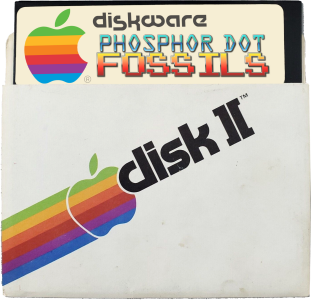 NASA releases
NASA releases 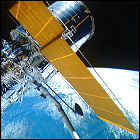 In the planning stages since the 1970s, and delayed by the post-Challenger-disaster downtime for the shuttle program, the Hubble Space Telescope is finally lifted into orbit aboard Space Shuttle Discovery. Hubble is just one of the scientific payloads for the five-day flight, with other experiments being conducted in the crew cabin and the cargo bay. Discovery’s crew for this flight is Commander Loren Shriver, Pilot Charles Bolden, and mission specialists Steven Hawley, Bruce McCandless and Kathryn Sullivan.
In the planning stages since the 1970s, and delayed by the post-Challenger-disaster downtime for the shuttle program, the Hubble Space Telescope is finally lifted into orbit aboard Space Shuttle Discovery. Hubble is just one of the scientific payloads for the five-day flight, with other experiments being conducted in the crew cabin and the cargo bay. Discovery’s crew for this flight is Commander Loren Shriver, Pilot Charles Bolden, and mission specialists Steven Hawley, Bruce McCandless and Kathryn Sullivan.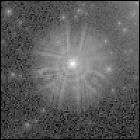 The earliest test images from the Hubble Space Telescope alert ground-based astronomers to a serious problem: the telescope’s huge mirror has been ground to an incorrect shape, leaving the $2,000,000,000 telescope with a vision problem resulting in blurry pictures. Though they’re still an improvement over ground-based telescopes, the telescope’s main selling point – high-resolution images of distant objects – is moot. With the public considering the expensive satellite a failure (oblivious to the fact that it can be serviced via Space Shuttle), NASA begins an extensive investigation into the problem, arriving at a possible repair that can’t be applied until the first shuttle servicing mission to Hubble in 1993. In the meantime, attempts to correct the problem with Earthbound computer image processing yield some usable images.
The earliest test images from the Hubble Space Telescope alert ground-based astronomers to a serious problem: the telescope’s huge mirror has been ground to an incorrect shape, leaving the $2,000,000,000 telescope with a vision problem resulting in blurry pictures. Though they’re still an improvement over ground-based telescopes, the telescope’s main selling point – high-resolution images of distant objects – is moot. With the public considering the expensive satellite a failure (oblivious to the fact that it can be serviced via Space Shuttle), NASA begins an extensive investigation into the problem, arriving at a possible repair that can’t be applied until the first shuttle servicing mission to Hubble in 1993. In the meantime, attempts to correct the problem with Earthbound computer image processing yield some usable images.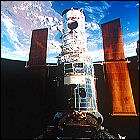 NASA launches Space Shuttle Endeavour on a ten-day mission to retrieve and repair the Hubble Space Telescope, which was launched in 1990 with flawed optics. With the $2,000,000,000 telescope held steady in the cargo bay, Endeavour astronauts conduct repairs during spacewalks totaling over 35 hours of the mission, before releasing Hubble back into orbit with new eyes. Aboard Endeavour for her history-making fifth flight are Commander Richard Covey, Pilot Kenneth Bowersox, Payload Commander Story Musgrave, and mission specialists Kathryn Thornton, Claude Nicollier, Jeffrey Hoffman and Tom Akers.
NASA launches Space Shuttle Endeavour on a ten-day mission to retrieve and repair the Hubble Space Telescope, which was launched in 1990 with flawed optics. With the $2,000,000,000 telescope held steady in the cargo bay, Endeavour astronauts conduct repairs during spacewalks totaling over 35 hours of the mission, before releasing Hubble back into orbit with new eyes. Aboard Endeavour for her history-making fifth flight are Commander Richard Covey, Pilot Kenneth Bowersox, Payload Commander Story Musgrave, and mission specialists Kathryn Thornton, Claude Nicollier, Jeffrey Hoffman and Tom Akers.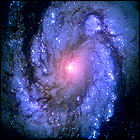 Following the Space Shuttle repair mission to the Hubble Space Telescope, the orbiting telescope’s new Wide Field and Planetary Camera 2 shows incredible improvement in image resolution. By determining the exact deformation of the telescope’s main mirror, the new camera is created almost like corrective glasses: it’s designed to compensate for that deformation at all times. The resulting improvement in image quality is remarkable, enabling Hubble to spot volcanic activity on Io, a moon of Jupiter whose volcanoes have only been visible from space probes making a close flyby. Hubble’s improved vision also arrives just in time to witness an unprecedented event: a cometary collision with Jupiter later in 1994.
Following the Space Shuttle repair mission to the Hubble Space Telescope, the orbiting telescope’s new Wide Field and Planetary Camera 2 shows incredible improvement in image resolution. By determining the exact deformation of the telescope’s main mirror, the new camera is created almost like corrective glasses: it’s designed to compensate for that deformation at all times. The resulting improvement in image quality is remarkable, enabling Hubble to spot volcanic activity on Io, a moon of Jupiter whose volcanoes have only been visible from space probes making a close flyby. Hubble’s improved vision also arrives just in time to witness an unprecedented event: a cometary collision with Jupiter later in 1994.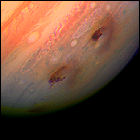 Its collision with the solar system’s largest planet predicted over a year in advance, the fragments of Comet Shoemaker-Levy 9 begin impacting Jupiter’s atmosphere in an astronomical event lasting six days. With Earth-based telescopes watching, as well as cameras and instruments on the Hubble Space Telescope, Galileo and even Voyager 2, huge explosions are witnessed as the cometary chunks slam into Jupiter’s southern hemisphere at over 200,000 miles per hour, leaving dark “scars” larger than the diameter of Earth visible on the planet’s atmosphere and releasing more heat than the surface of the sun. Galileo is still over a year away from arriving at Jupiter.
Its collision with the solar system’s largest planet predicted over a year in advance, the fragments of Comet Shoemaker-Levy 9 begin impacting Jupiter’s atmosphere in an astronomical event lasting six days. With Earth-based telescopes watching, as well as cameras and instruments on the Hubble Space Telescope, Galileo and even Voyager 2, huge explosions are witnessed as the cometary chunks slam into Jupiter’s southern hemisphere at over 200,000 miles per hour, leaving dark “scars” larger than the diameter of Earth visible on the planet’s atmosphere and releasing more heat than the surface of the sun. Galileo is still over a year away from arriving at Jupiter.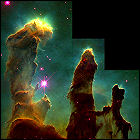 The Hubble Space Telescope, observing M16 (also known as the Eagle Nebula), takes what may be its most famous image: towering clouds of rapidly-evaporating interstellar gas which scientists theorize are the birthplace of new stars. The huge, light-years-long hydrogen clouds are dubbed evaporating gaseous globules, or EGGs; astronomers also call the structure a stellar nursery. The image quickly becomes a mainstay of the media, making appearances in Babylon 5 and the movie Contact.
The Hubble Space Telescope, observing M16 (also known as the Eagle Nebula), takes what may be its most famous image: towering clouds of rapidly-evaporating interstellar gas which scientists theorize are the birthplace of new stars. The huge, light-years-long hydrogen clouds are dubbed evaporating gaseous globules, or EGGs; astronomers also call the structure a stellar nursery. The image quickly becomes a mainstay of the media, making appearances in Babylon 5 and the movie Contact. 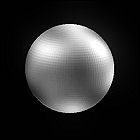 After decades of the tiny object being seen only as a point of light in even the best telescopic images, the Hubble Space Telescope makes the first survey of the surface of Pluto. Even without the distortion introduced by Earth’s atmosphere, Hubble’s best shots of Pluto are vague due to the distance from Earth to Pluto, but they mark the first time that even blurry surface detail has been seen. The new images help NASA gain support for a Pluto flyby mission in the 21st century, which will eventually be named New Horizons.
After decades of the tiny object being seen only as a point of light in even the best telescopic images, the Hubble Space Telescope makes the first survey of the surface of Pluto. Even without the distortion introduced by Earth’s atmosphere, Hubble’s best shots of Pluto are vague due to the distance from Earth to Pluto, but they mark the first time that even blurry surface detail has been seen. The new images help NASA gain support for a Pluto flyby mission in the 21st century, which will eventually be named New Horizons.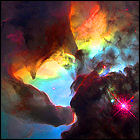 NASA’s Hubble Space Telescope does some interstellar storm spotting, capturing an image of funnel-cloud-shaped structures in the Lagoon Nebula, 5,000 light years away from Earth. Similar to the star-forming structures in the Eagle Nebula, the Lagoon Nebula’s star-birthing clouds are seen to be twisting into tornado-like shapes, possibly due to interactions of gases with extreme hot and cold temperatures, not unlike the weather processes leading to tornado formation on Earth.
NASA’s Hubble Space Telescope does some interstellar storm spotting, capturing an image of funnel-cloud-shaped structures in the Lagoon Nebula, 5,000 light years away from Earth. Similar to the star-forming structures in the Eagle Nebula, the Lagoon Nebula’s star-birthing clouds are seen to be twisting into tornado-like shapes, possibly due to interactions of gases with extreme hot and cold temperatures, not unlike the weather processes leading to tornado formation on Earth.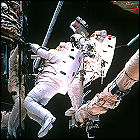 Space Shuttle Discovery lifts off on a ten-day mission to service the Hubble Space Telescope. Over 30 hours of spacewalks are conducted to repair and upgrade Hubble with new parts, and the shuttle engines are fired in short, steady bursts to raise the telescope’s orbit by over eight miles before it is released again. Aboard Discovery on her 22nd flight are Commander Kenneth Bowersox, Pilot Scott Horowitz, and mission specialists Mark Lee, Steven Hawley, Gregory Harbaugh, Steven Smith and Joseph Tanner.
Space Shuttle Discovery lifts off on a ten-day mission to service the Hubble Space Telescope. Over 30 hours of spacewalks are conducted to repair and upgrade Hubble with new parts, and the shuttle engines are fired in short, steady bursts to raise the telescope’s orbit by over eight miles before it is released again. Aboard Discovery on her 22nd flight are Commander Kenneth Bowersox, Pilot Scott Horowitz, and mission specialists Mark Lee, Steven Hawley, Gregory Harbaugh, Steven Smith and Joseph Tanner.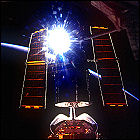 Space Shuttle Discovery lifts off on an eight-day mission to retrieve, service and redeploy the Hubble Space Telescope. This routine planned upgrade for Hubble sees the shuttle crew swapping out the $2,000,000,000 telescope’s CPU, installing a new one with 20 times the processing power of the original, during an eight-hour spacewalk; another eight-hour spacewalk sees crewmembers removing an analog data recorder to replace it with a digital device with greater capacity. Christmas 1999 is spent placing Hubble back into its orbit. Aboard Discovery for her 27th flight are Commander Curtis Brown, Pilot Scott Kelly, and mission specialists Steven Smith, Michael Foale, John Grunsfield, Claude Nicollier and Jean-Francois Clervoy.
Space Shuttle Discovery lifts off on an eight-day mission to retrieve, service and redeploy the Hubble Space Telescope. This routine planned upgrade for Hubble sees the shuttle crew swapping out the $2,000,000,000 telescope’s CPU, installing a new one with 20 times the processing power of the original, during an eight-hour spacewalk; another eight-hour spacewalk sees crewmembers removing an analog data recorder to replace it with a digital device with greater capacity. Christmas 1999 is spent placing Hubble back into its orbit. Aboard Discovery for her 27th flight are Commander Curtis Brown, Pilot Scott Kelly, and mission specialists Steven Smith, Michael Foale, John Grunsfield, Claude Nicollier and Jean-Francois Clervoy.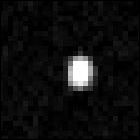 NASA’s Hubble Space Telescope spots an object beyond the orbit of Pluto, and approximately half the size of Pluto – the largest object discovered in the solar system in over 70 years. With a circular orbit that’s a billion miles further from the sun than Pluto, the body is determined to be approximately 800 miles in diameter. Quaoar is believed to be the largest Kuiper Belt object discovered to date, though its thunder will be stolen a few years later with the discovery of Eris and the demotion of Pluto to a dwarf planet.
NASA’s Hubble Space Telescope spots an object beyond the orbit of Pluto, and approximately half the size of Pluto – the largest object discovered in the solar system in over 70 years. With a circular orbit that’s a billion miles further from the sun than Pluto, the body is determined to be approximately 800 miles in diameter. Quaoar is believed to be the largest Kuiper Belt object discovered to date, though its thunder will be stolen a few years later with the discovery of Eris and the demotion of Pluto to a dwarf planet.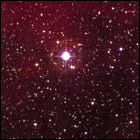 NASA’s Hubble Space Telescope makes an astonishing discovery while observing one of the first planets discovered beyond Earth’s solar system. The gas giant planet designated HD 209458b, orbiting the star HD 209458 in the constellation of Pegasus, 150 light years from Earth, is losing its atmosphere. Slightly larger than Jupiter, but locked into a dizzyingly tight orbit around its star (only 4,000,000 miles, with its “year” lasting less than half of an Earth week), HD 209458b’s atmosphere is boiling away into space thanks to the heat of the nearby star. This leads to a new exoplanet classification, “Hot Jupiters,” used to describe gas giants in similarly suicidal orbits. The core of HD 209458b will probably not last long once the last remnants of its atmosphere dissipate.
NASA’s Hubble Space Telescope makes an astonishing discovery while observing one of the first planets discovered beyond Earth’s solar system. The gas giant planet designated HD 209458b, orbiting the star HD 209458 in the constellation of Pegasus, 150 light years from Earth, is losing its atmosphere. Slightly larger than Jupiter, but locked into a dizzyingly tight orbit around its star (only 4,000,000 miles, with its “year” lasting less than half of an Earth week), HD 209458b’s atmosphere is boiling away into space thanks to the heat of the nearby star. This leads to a new exoplanet classification, “Hot Jupiters,” used to describe gas giants in similarly suicidal orbits. The core of HD 209458b will probably not last long once the last remnants of its atmosphere dissipate.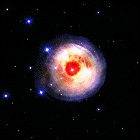 Following up on observations from Earth-based telescopes, NASA’s Hubble Space Telescope is pointed toward the star V838 Monocerotis – an object of very little previous interest – to discover why it’s suddenly the brightest thing in the entire Milky Way Galaxy. What Hubble sees surprises scientists on the ground: a “shell” of matter surrounding the star, illuminated from within and expanding outward into space (actual photo sequence seen here). What astronomers had seen previously was the illumination of the dust cloud, which is much larger than the star itself. Scientists theorize that the expanding dust cloud is not an indication of a supernova, but a sign that V838 Monocerotis is expanding, expelling gas and then shrinking again. The star is over 20,000 light years from Earth.
Following up on observations from Earth-based telescopes, NASA’s Hubble Space Telescope is pointed toward the star V838 Monocerotis – an object of very little previous interest – to discover why it’s suddenly the brightest thing in the entire Milky Way Galaxy. What Hubble sees surprises scientists on the ground: a “shell” of matter surrounding the star, illuminated from within and expanding outward into space (actual photo sequence seen here). What astronomers had seen previously was the illumination of the dust cloud, which is much larger than the star itself. Scientists theorize that the expanding dust cloud is not an indication of a supernova, but a sign that V838 Monocerotis is expanding, expelling gas and then shrinking again. The star is over 20,000 light years from Earth.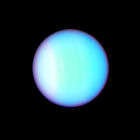 Astronomers using the Hubble Space Telescope discover two new moons of Uranus that eluded detection during Voyager 2’s 1986 flyby: Cupid and Mab. Both small, dark bodies that orbit closer to Uranus than any of the planet’s large satellites, Cupid and Mab raise the number of known Uranian satellites above 20. Mab’s orbit keeps it within the planet’s outermost ring, while Cupid’s orbit is only 500 miles further out than that of Belinda, one of the small moons discovered in 1986 by Voyager 2. Cupid is the tiniest of the inner moons of Uranus, roughly 11 miles in diameter.
Astronomers using the Hubble Space Telescope discover two new moons of Uranus that eluded detection during Voyager 2’s 1986 flyby: Cupid and Mab. Both small, dark bodies that orbit closer to Uranus than any of the planet’s large satellites, Cupid and Mab raise the number of known Uranian satellites above 20. Mab’s orbit keeps it within the planet’s outermost ring, while Cupid’s orbit is only 500 miles further out than that of Belinda, one of the small moons discovered in 1986 by Voyager 2. Cupid is the tiniest of the inner moons of Uranus, roughly 11 miles in diameter.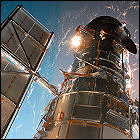 Space Shuttle Atlantis lifts off on the 126th shtutle flight, the final servicing mission to the Hubble Space Telescope (and the only post-Columbia flight not to visit the International Space Station). The repairs and upgrades conducted during a series of spacewalks will extend Hubble’s operation life through at least 2014. Aboard Atlantis for her 30th flight are Commander Scott Altman, Pilot Greg Johnson, and mission specialists John Grunsfeld, Michael Massimino, Andrew Feustel, Michael Good and Megan McArthur. This mission was nearly cancelled in light of post-Columbia flight rules requiring all shuttle flights to visit the space station.
Space Shuttle Atlantis lifts off on the 126th shtutle flight, the final servicing mission to the Hubble Space Telescope (and the only post-Columbia flight not to visit the International Space Station). The repairs and upgrades conducted during a series of spacewalks will extend Hubble’s operation life through at least 2014. Aboard Atlantis for her 30th flight are Commander Scott Altman, Pilot Greg Johnson, and mission specialists John Grunsfeld, Michael Massimino, Andrew Feustel, Michael Good and Megan McArthur. This mission was nearly cancelled in light of post-Columbia flight rules requiring all shuttle flights to visit the space station.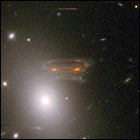 To allay public fears that the next level might not be reached, NASA offers an explanation for an enigmatic 2010 image from the Hubble Space Telescope, showing a galaxy cluster, Abell 68, approximately 2,000,000,000 light years away. In the middle of that cluster, however, is what appears to be an alien from the video game Space Invaders. NASA explains that it’s a visual artifact of gravitational lensing caused by the gravity influence of the foreground galaxies upon the light of galaxies further away in the image. Earth breathes easy once more.
To allay public fears that the next level might not be reached, NASA offers an explanation for an enigmatic 2010 image from the Hubble Space Telescope, showing a galaxy cluster, Abell 68, approximately 2,000,000,000 light years away. In the middle of that cluster, however, is what appears to be an alien from the video game Space Invaders. NASA explains that it’s a visual artifact of gravitational lensing caused by the gravity influence of the foreground galaxies upon the light of galaxies further away in the image. Earth breathes easy once more.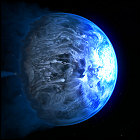 Scientists, analyzing Hubble Space Telescope spectographic data taken during a transit of the exoplanet HD 189733b against its parent star, reveal that they have determined the planet’s color in visible light. The doomed gas giant, only 63 light years away, is said to be a “deep azure blue” not unlike how Earth’s oceans appear from space, though in this case the color is theorized to be the result not of water, but of silicate rain – airborne glass – blowing in 7,000mph winds as the atmosphere is blasted away due to the planet’s proximity to its sun.
Scientists, analyzing Hubble Space Telescope spectographic data taken during a transit of the exoplanet HD 189733b against its parent star, reveal that they have determined the planet’s color in visible light. The doomed gas giant, only 63 light years away, is said to be a “deep azure blue” not unlike how Earth’s oceans appear from space, though in this case the color is theorized to be the result not of water, but of silicate rain – airborne glass – blowing in 7,000mph winds as the atmosphere is blasted away due to the planet’s proximity to its sun.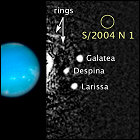 Using Hubble Space Telescope images of Neptune taken between 2004 and 2009, astronomers discover a 14th moon circling the outermost planet of the solar system. Not given an official, mythologically-derived name yet, the moon is initially designated S/2004 N1, and is a small, dark body with a diameter of roughly 12 miles, making it Neptune’s smallest discovered satellite to date, orbiting the planet once a day at a distance of 65,400 miles.
Using Hubble Space Telescope images of Neptune taken between 2004 and 2009, astronomers discover a 14th moon circling the outermost planet of the solar system. Not given an official, mythologically-derived name yet, the moon is initially designated S/2004 N1, and is a small, dark body with a diameter of roughly 12 miles, making it Neptune’s smallest discovered satellite to date, orbiting the planet once a day at a distance of 65,400 miles.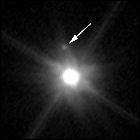 Astronomers reveal that Makemake, an icy dwarf planet orbiting in the distant Kuiper Belt region of the solar system, has a moon, first spotted in 2015 by a team using the Hubble Space Telescope. (The news comes just days after the 26th anniversary of Hubble’s launch.) With an estimated diameter of 100 miles (compared to the 870 mile diameter of its parent body), the satellite orbits Makemake at a distance of 13,000 miles, taking twelve days to complete one orbit. Previous observations failed to pick up on the dark, dim body due to the relatively bright glare of Makemake itself.
Astronomers reveal that Makemake, an icy dwarf planet orbiting in the distant Kuiper Belt region of the solar system, has a moon, first spotted in 2015 by a team using the Hubble Space Telescope. (The news comes just days after the 26th anniversary of Hubble’s launch.) With an estimated diameter of 100 miles (compared to the 870 mile diameter of its parent body), the satellite orbits Makemake at a distance of 13,000 miles, taking twelve days to complete one orbit. Previous observations failed to pick up on the dark, dim body due to the relatively bright glare of Makemake itself. 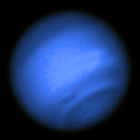 NASA’s Hubble Space Telescope confirms the observations of Earthbound astronomers with high-powered telescopes: a new dark atmospheric feature has emerged on the planet Neptune, signifying a major new storm system in the planet’s atmosphere. The new vortex feature emerges near the south polar area of Neptune, and was first observed by telescope in 2015.
NASA’s Hubble Space Telescope confirms the observations of Earthbound astronomers with high-powered telescopes: a new dark atmospheric feature has emerged on the planet Neptune, signifying a major new storm system in the planet’s atmosphere. The new vortex feature emerges near the south polar area of Neptune, and was first observed by telescope in 2015.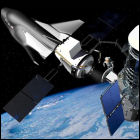 Though it has yet to actually go to space, the Sierra Nevada Dream Chaser spacecraft is floated as a possible savior for the Hubble Space Telescope, with a very preliminary mission proposal for a repair mission to the telescope which has now been operational in orbit for over a quarter of a century. The possible mission is brought forth as an example of increasing high-profile cooperation between NASA and private space companies. The Dream Chaser’s earliest orbit test flights are not expected to take place prior to 2019; if the mission takes place in 2020 at the earliest, Hubble will by then be 30 years old.
Though it has yet to actually go to space, the Sierra Nevada Dream Chaser spacecraft is floated as a possible savior for the Hubble Space Telescope, with a very preliminary mission proposal for a repair mission to the telescope which has now been operational in orbit for over a quarter of a century. The possible mission is brought forth as an example of increasing high-profile cooperation between NASA and private space companies. The Dream Chaser’s earliest orbit test flights are not expected to take place prior to 2019; if the mission takes place in 2020 at the earliest, Hubble will by then be 30 years old.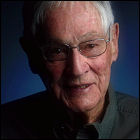 Bradford A. Smith, a research astronomer and former professor of planetary science and astronomy at the University of Arizona, dies at the age of 86 from complications arising from an autoimmune disorder. Smith became a public figure during the peak years of the uncrewed
Bradford A. Smith, a research astronomer and former professor of planetary science and astronomy at the University of Arizona, dies at the age of 86 from complications arising from an autoimmune disorder. Smith became a public figure during the peak years of the uncrewed 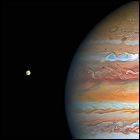 NASA and ESA announce that spectrographic analysis of Hubble Space Telescope data gathered during observations of Jupiter’s icy moon Europa reveals that Europa has a persistent atmosphere of water vapor, but only on the hemisphere of the moon that is opposite of the direction of its orbital motion. (This unusual effect had been predicted in computer modeling, but had not been directly observed until now.) The atmosphere is present in Hubble spectroscopy data as old as 1999 and as recent as 2015. The stability of the water vapor in the atmosphere is the real surprise find, since surface-based water was assumed to be in solid ice form.
NASA and ESA announce that spectrographic analysis of Hubble Space Telescope data gathered during observations of Jupiter’s icy moon Europa reveals that Europa has a persistent atmosphere of water vapor, but only on the hemisphere of the moon that is opposite of the direction of its orbital motion. (This unusual effect had been predicted in computer modeling, but had not been directly observed until now.) The atmosphere is present in Hubble spectroscopy data as old as 1999 and as recent as 2015. The stability of the water vapor in the atmosphere is the real surprise find, since surface-based water was assumed to be in solid ice form.